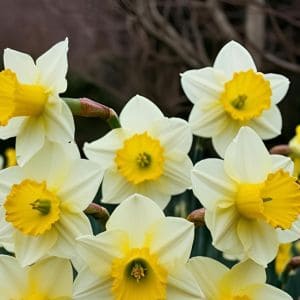Daffodils are a beautiful addition to any garden, bringing a burst of color in spring. Knowing when to divide your daffodils can keep them healthy and blooming year after year. The best time to divide daffodils is right after they finish flowering, usually in late spring or early summer.
This post may contain affiliate links.
When you divide your daffodils, you help them grow stronger and produce more flowers. This process not only keeps your garden looking its best, but it also encourages new bulbs to form. If your daffodils start to look crowded or the blooms are smaller than usual, dividing them can make a big difference.
By taking the time to properly divide your daffodils, you ensure that they continue to thrive in your garden. It’s a simple step that can lead to a more vibrant spring display. Get ready to enjoy an even more colorful garden next season!
Related Article: Best Companion Plants for Daffodils: Enhance Your Garden’s Beauty

Understanding Daffodil Propagation
Daffodils are popular flowering bulbs known for their bright blooms and easy care. To grow these lovely flowers, it’s important to know about their parts and how they grow throughout their life cycle.
Daffodil Bulb Anatomy
Daffodil bulbs consist of several key parts. The outer skin protects the bulb from damage. Inside, you’ll find layers called scales that store food and energy. These scales are where the bulb gets its nutrients.
At the center is the growing point, which will develop into the leaves and flowers. Beneath the scales, there are small roots that absorb water and nutrients from the soil. Understanding this anatomy helps you know how to care for your daffodils properly, especially when it’s time to divide them.
Related Article: How to Transplant Daffodils: A Simple Guide for Beautiful Blooms
Lifecycle of Daffodils
Daffodils have a unique lifecycle. In the spring, they emerge from the ground, producing green leaves and bright flowers. These flowers bloom for a few weeks before wilting. After blooming, the leaves continue to grow and photosynthesize, storing energy in the bulb for next year.
Once summer arrives, the foliage begins to die back. This period is crucial as it allows the bulb to gather energy for the next cycle. If conditions are right, bulbs can multiply and create offsets. When daffodils crowd each other, it’s a good time to divide them to ensure healthy growth and plentiful blooms in the future.
Optimal Care for Daffodils
Taking care of daffodils is simple and rewarding. With the right timing and methods for dividing their bulbs, you can enjoy their vibrant blooms each spring. Here’s how to ensure your daffodils thrive.
Related Article: Growing Daffodils in Pots: Tips and Tricks for a Beautiful Display
Best Time to Divide Daffodils
The best time to divide daffodils is right after they finish blooming. This usually happens in late spring or early summer.
Wait until the leaves begin to yellow and die back. This process helps the bulbs store energy for the next season.
If you divide them too early, they may not have enough nutrients left. If you wait too long, the bulbs can become crowded.
Keep an eye on the blooms, and you’ll know when the timing is right!

Related Article: How to Divide Daylilies: A Complete Guide to Healthy Growth
How to Divide Daffodil Bulbs
To divide daffodil bulbs, start by digging around the bulb cluster. Use a spade or garden fork to carefully lift them from the soil.
Take care not to damage the bulbs. Once lifted, gently shake off the soil.
You’ll see smaller bulbs connected to a larger bulb. Separate these smaller bulbs by hand.
Trim any damaged roots and remove any dead or diseased parts. You can store them temporarily in a cool, dry place if you can’t plant them right away.
Aftercare for Divided Bulbs
After dividing the daffodil bulbs, it’s time to replant them.
Choose a sunny spot in your flower bed with well-drained soil.
Plant bulbs about 6 to 8 inches apart and 6 inches deep, ensuring the pointed end faces up.
Adding a little phosphorus-rich fertilizer can help their growth. Water them lightly after planting to settle the soil.
During their first season, keep an eye on moisture levels. Make sure not to overwater, as this can cause rot.
With the right care, your daffodils will reward you with beautiful blooms for years to come!
Follow my spring bulbs board on Pinterest.




